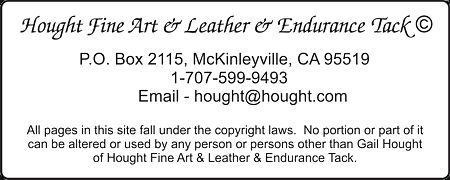|
4/19/02
YOU TRY IT
Tonight take an hour or so, sit down to
your desk or computer and put into writing how you stop your
horse. This is not as simple as it sounds, trust me. We do too
many things automatically without thinking, combined by the horse
feeling you and stopping on his own. At any rate, we overlook
way too much. What's the value of this project? Simple, it causes
us to analyze a maneuver and ourselves.
Let's say you are loping along in a relaxed gait, no pushing.
"Ask" him to stop. My signals are legs, hands,
upper body weight, seat and voice. It is important to "ask"
for the stop rather than by "pulling" the horse to
a stop. Asking, waiting and riding through the stop is difficult.
What's the first thing you do? What does your horse
do? Are you sure? Try it on your next ride.
Make sure you are perfectly balanced forward and backward, and
your centerline is on your horses centerline. Important: Sit
perfectly still. If you make a weight change it is a cue
whether intended or not. Keeping this in mind enables you to
make subtle changes to get the expected results. If, on the other
hand, you are flopping around, paying little attention to the
horse's sensitivity, how will the horse be able to decipher a
cue from your error? Think about it.
All riders have a style or system they use. I pick and choose
from others what things I can incorporate into my system. Tempest
is hearing the suggestions because I am consistent, sit still
and wait for her to hear me. How long do I wait? Until she hears
it or executes the move correctly.
How do you prepare yourself for a stop? Hummmm.
The first thing I do is check to see if I am centered, sitting
still and not sending any other signal. If I find something,
I fix it . I then take my legs off of her sides and begin pushing
on the stirrups. She begins to slow because I have taken my foot
off of the accelerator, figuratively speaking. This is the start
of something good. Other cues are going to her simultaneously.
It all goes together, balance, timing, listening and waiting.
If she doesn't hear the cue I will repeat the cue or increase
the intensity of the signal until she executes the desired response.
If I have to pull her to a stop I will settle her and lope off
to try again. Those are the only results of her not hearing me.
That way she doesn't become unsettled about the stop. Keep
it simple. |
